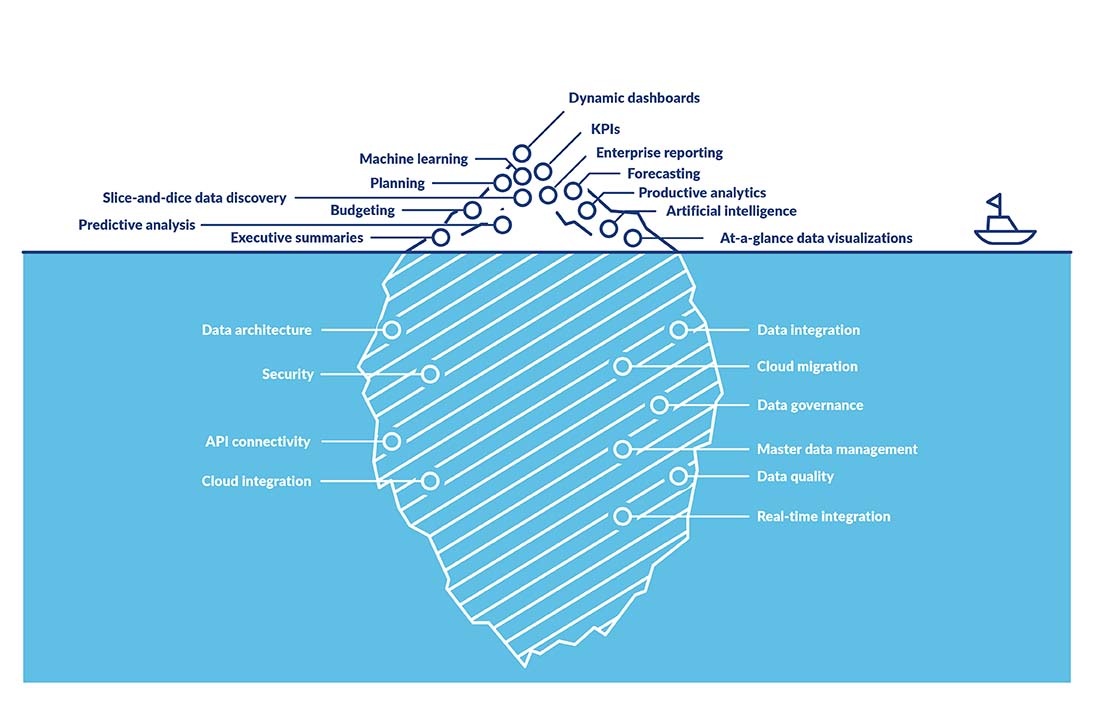Are you drowning in a sea of data? If not, good for you — no need to keep reading. But if you’re like a lot of professional services firms, you’ve got years of data that you have no idea how to use. Perhaps you think you’re using the data, but your data isn’t accurate because you haven’t paid enough attention to the data governance, architecture, or other behind-the-scenes necessities. Maybe each geography of your business has their own data-tracking quirks, or the system you use doesn’t generate a simple report that you can use to make decisions. Whatever the issue is, it’s natural to be overwhelmed and unsure of where to start. However, the time to take those first steps is now — your competition won’t wait, so read on for a quick education and some ideas for how to get started.
What’s “business analytics?”
If you imagine the entire process as an iceberg, that small, visible portion of the iceberg that sits above the water would be the front-end reports, useful visualizations, and KPI metrics. It’s basically the result of data collection that you can use to make decisions. The large part under the water that you can’t see encompasses everything that goes on behind the scenes, and is just as much a part of a successful business analytics environment.
Because that large underwater chunk isn’t visible, it tends to get ignored, but in order for your “front-end content” (the iceberg above the waterline) to be useful and accurate, it needs a lot of attention. These are things like data governance, data security, real-time integration, and everything else that ensures the data is accurate, in the right place, and properly protected.
Business analytics challenges professional services firms face

Do these common issues sound familiar?
- Siloed data - Having to pull data from multiple sources is time-consuming and complicated. If different groups in your firm are using different tools to track data, it creates a barrier to successful business analytics. Making data-driven decisions requires having one version of the truth.
- Inaccurate data or other quality issues - If your data’s inaccurate, how can you use it to make decisions? Inconsistency in tracking methods can be a factor, as can a lack of data governance practices. It’s not uncommon for companies to have different versions of the same data as well.
- Difficulty pulling reports - We’ve heard all these quotes and more from discouraged clients whose data systems aren’t serving them. “The person who used to pull those reports left the firm, and nobody else knows how to pull them.” “I don’t want to spend every weekend dragging data out of Excel.” “Our system is too complicated, and I don’t know how to get the data I need.” If reports are too complex to pull, or too slow to be pulled regularly, it’s time for a change.
- Frustrations with technology - The truth is, the holy grail of a “fully integrated one-system system” isn’t realistic right now — new technologies are being developed constantly and the need for change is embraced slowly. Having a data-driven innovation strategy, as opposed to a software strategy, allows for a foundation to stay nimble and innovative in the future. When companies don’t take this approach, executives lose confidence in their companies’ ability to “win” with technology and often feel that they’re spending more and more money with no improvement in effectiveness.
- Expecting new tools to fix problems - “I just bought this new software tool to fix my problems, but I still have the problem,” is a common complaint we hear from business leaders. People and process, along with technology, is the recipe for success. To make the most of your technology, it’s critical to have a process in place to help govern the way your people use tools and prevent the issues described above. Software doesn’t solve problems — people do. Having executive sponsorship with buy-in from the staff will lead to higher success.
It starts with a data strategy
If your firm has attempted data-wrangling in the past and wound up with little more than a big bill, maybe all you were missing was a strategy. If you have the necessary knowledge, you can create one on your own, or you can outsource it to the experts (and we don’t mean the account manager who sold you whatever data management software you’re currently using). When you have a competent strategy, you can focus on just the information you want at your fingertips, rather than wasting time sifting through a sea of data.
If you’re successfully implementing business analytics, you’ll have a single version of the truth that enables increased, improved, and faster communications across functional teams. Teams are less likely to create their “own version” of key reports that lack consistency and discourage teaming. It also leads to increased productivity. We’ve heard CEOs say they’ll spend up to 10 hours a month to get a report that they use to make major decisions, but with a refined data strategy, that can be cut way down. Becoming a data-driven organization can increase the quality and speed of information, increase productivity, and drive better overall business decisions.
It’s important to note that any good data strategy will involve leadership setting the tone for data governance. If executives want teams to stop doing things their own way or getting lax with data quality, they’ll have to walk the talk themselves. What’s more, what may seem obvious to you might need to be spelled out to others, so communication is vital.
How to get started with business analytics
The best way to jump into business analytics is with a quick win to provide value early and fast. Consider your business analytics maturity level and what it might take to advance to the next one. Cost doesn’t have to be a barrier — a two- to three-week project to address just one issue is a great place to start. When clients come to us for help but they’re not quite ready for a full overhaul, we start small with something like a two-day site visit to discover which issues are holding you back and identify some of the lowest-hanging fruit that will make the biggest impact. Whatever your pilot project is, your success will put you on an upward spiral toward better and faster decision-making. Give us a call, and we can help you figure out your next steps.





